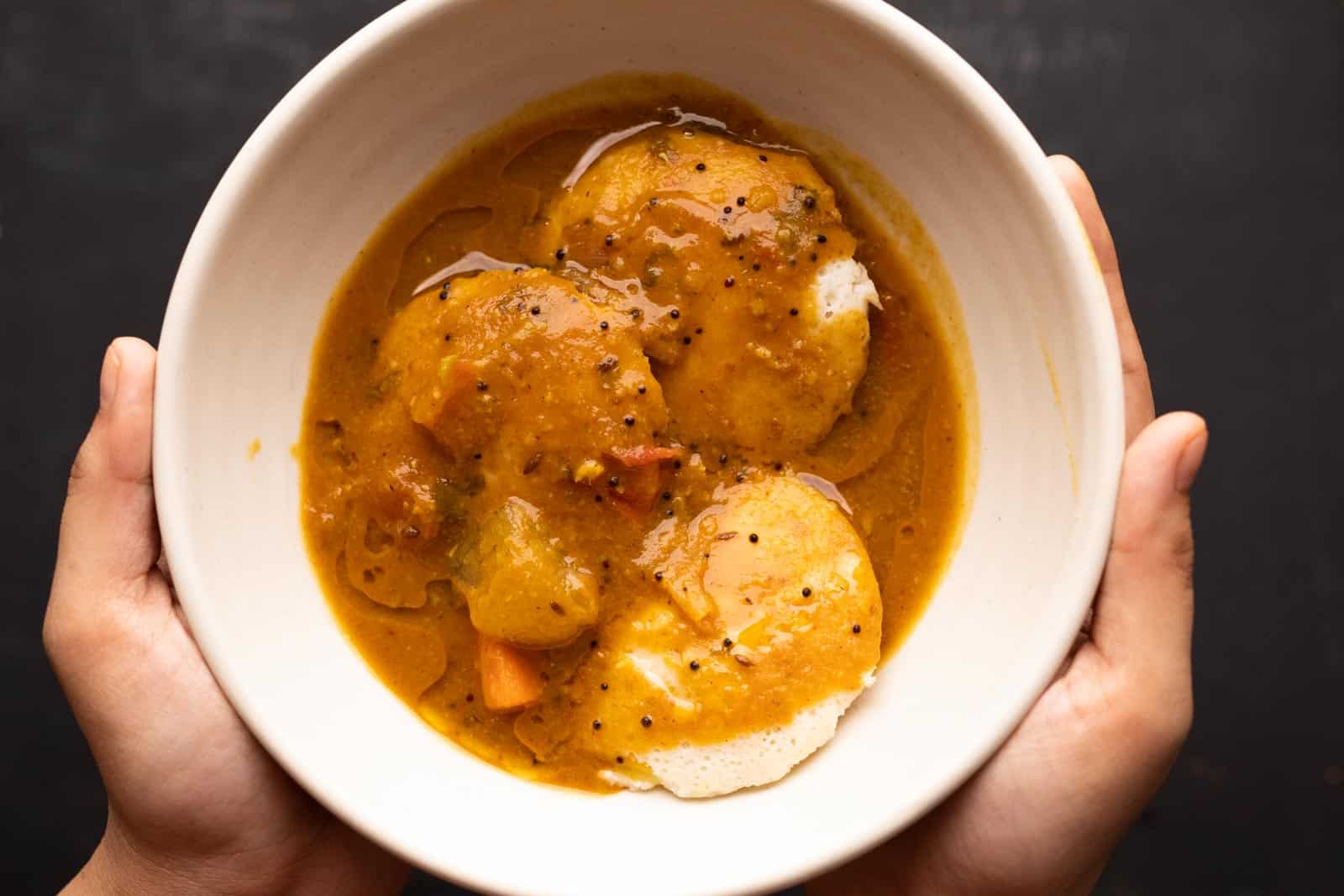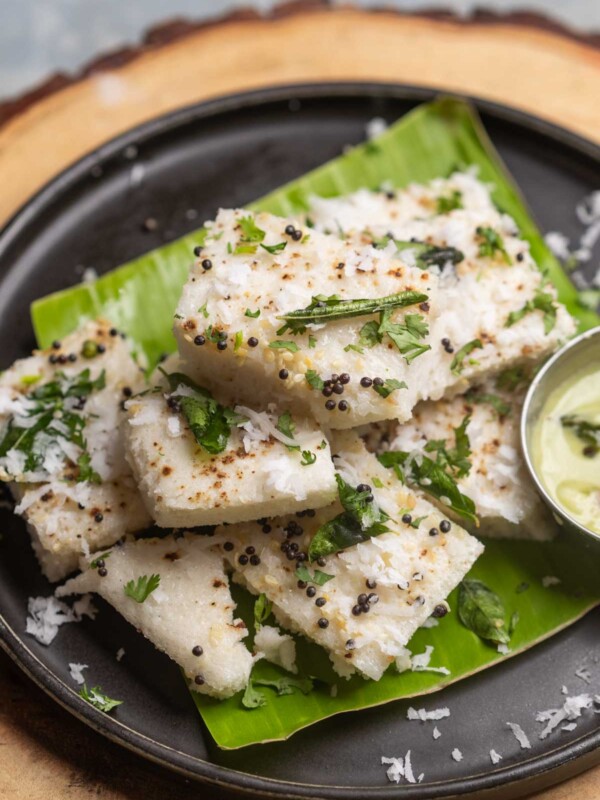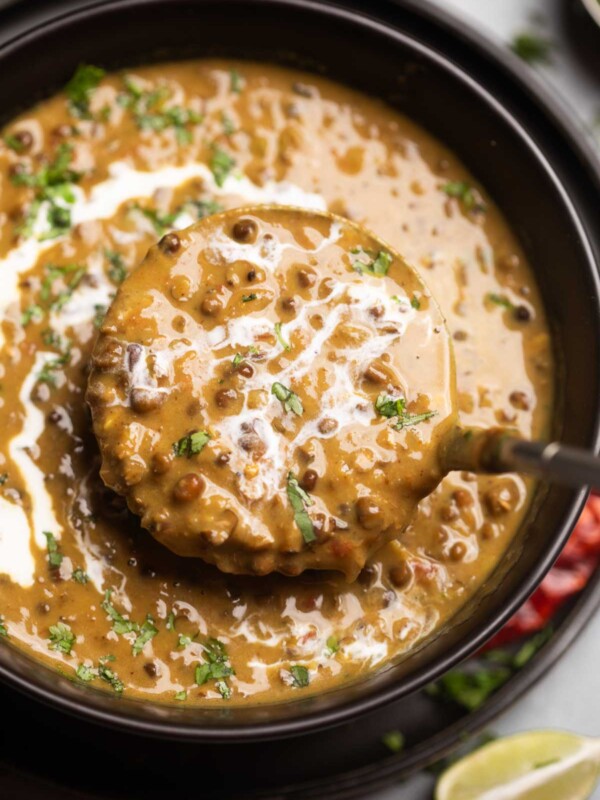One Pot Sambar | Fast & Easy
on Aug 20, 2025
This post may contain affiliate links. Please read our disclosure policy.
Craving a comforting bowl of sambar with idlis and dosas? This one-pot sambar recipe is the perfect solution — quick, flavorful, and made effortlessly in a pressure cooker!

I am the kind of person who cannot imagine having my idlis and dosas without a big bowl of piping hot sambar on my plate. I think it’s the perfect way to round up the simple flavors of idli and dosa, as well as make the meal more nutritious.
And considering how often we make South Indian dishes in this household, the whole shabang of making sambar the traditional way started to feel too cumbersome pretty soon. Enter: My one pot sambar recipe! With no compromise on the taste or texture, it delivers all the authentic South Indian goodness in a fraction of the time. So if you love sambar but like me, not the long cooking, this quick method might just become your new go-to.
Jump to section: One Pot Sambar

One Pot Sambar Ingredients
For the sambar:
- Toor dal: Split pigeon peas form the base of this sambar.
- Aromatics: Garlic, green chillies, and curry leaves for flavor and aroma
- Veggies: Diced carrots, tomatoes, sambar onions, or cubed regular onions, beans, and drumsticks add lots of flavor, texture, and nutrition
- Spices: Turmeric, red chilli, and coriander powders along with sambar powder for warmth and flavor
- Tamarind pulp: For a nice, refreshing tang. I highly recommend not skipping this
- Salt: For seasoning
- Water: To pressure cook and adjust consistency
- Oil: Prevents the dal from overflowing and foaming when releasing pressure. Any neutral-flavored oil such as vegetable, sunflower, peanut, canola, etc.
For tempering:
- Ghee or oil: Ghee adds a really nice flavor and richness, but you can replace it with any neutral-flavored oil to make it vegan
- Spices: Mustard seeds, cumin seeds, hing or asafoetida, and curry leaves for warmth, flavor, and aroma
- Fenugreek seeds: It adds aroma and more depth of flavor to the sambar, along with aiding in digestion. A little goes a long way here. You can skip it if you don’t have it. Coriander leaves: Finely chopped for garnish. Adds fresh, earthy flavors to the whole dish
How to Make One Pot Sambar
Unlike the traditional sambar recipe that This one pot sambar recipe comes together entirely in the pressure cooker in just three simple steps:
01 Cooking dal: We start by pressure cooking our toor dal along with some turmeric powder, tomato, and oil until everything is cooked down and soft
02 Making sambar: Now to the same pressure cooker, we add all our veggies, curry leaves, tamarind, and spice powders and cook for one more whistle
03 Tempering: Once everything is cooked through, we make a tadka with mustard and cumin seeds, hing, curry leaves, etc. add it to the prepared sambar in the pressure cooker, mix everything well, and that’s it–our delicious, warming, one-pot sambar is ready to be served!
What is sambar powder
Sambar powder is a special spice and lentil mix blend that lends sambar its authentic flavor, warmth, and aroma. It’s usually made from chana dal (split chickpeas) as the base along with spices like coriander seeds, dried red chillies, cumin seeds, fenugreek seeds, and hing (asafoetida). Some people also add peppercorns to this blend, but that’s optional.
Sambar powder is easily available at most grocery stores online and offline in India, and at local Indian stores outside India. You can also easily make it at home in under 15 minutes. It has a long shelf life (stays good in the fridge for up to 6 months). In my experience, homemade sambar powder makes the dish a lot more flavorful, but store-bought can easily be used in a pinch.

Common Sambar Vegetables
Even though this sambar recipe uses just a handful of veggies, there are so many you can choose from. Here are all the veggies you can add depending on preference and availability:
- Potato
- Carot
- Drumstick
- Beans
- Cauliflower
- Pumpkin
- Ladies Finger or Okra
- Brinjal or Egg plant
- Radish
- Bottle gourd
- Broad beans
- Long beans
- Plantains
Which lentils work best in Sambar?
Traditionally sambar uses just just toor dal or split pigeon peas and that’s what we have used for this one pot sambar recipe as well. However, you can use a mix of toor and moong or masoor dal. The flavor will change a little bit, but it will still be delicious!
Frequently Asked Questions
Sambar and dal are both lentil-based dishes, but here’s how the two are different:
– Sambar is generally made with just toor dal, contains lots of veggies, has a sour flavor, and has many more spices than a regular dal
– Dal on the other hand can be made with toor, masoor, chana, or moong dal, or even a mix of various dals and usually has no veggies. It has a thicker, creamier consistency as compared to sambar which is usually more watery.
Yes, absolutely! Sambar powder adds more warmth and an authentic flavor to the sambar, but you can easily skip it in a pinch. Even though the taste will differ slightly, the sambar will still be delicious.
Richa’s Top Tips
- Follow the pressure cooking time mentioned in the recipe card, especially when cooking the veggies. We need our veggies to be completely cooked, but still have a little bite. Over cooking will lead to mushy veggies, which is not ideal for this sambar recipe
- Sambar is generally watery, but feel free to adjust the consistency to your liking.
- I would highly recommend using fresh spices and lentils for the best flavor and texture
- It’s important to make the tempering on a medium flame to avoid burning and keep the spices and herbs aromatic
- This sambar has medium spiciness and sourness. You can easily adjust the quantities of chilli powder, and tamarind to suit your preference. You can also add some jaggery to balance out the sourness if you like.
- Ghee is traditionally to temper as it adds a beautiful richness and aroma to the sambar. However, you can easily replace it with coconut oil or neutral-flavored oil to make it vegan.
Storage Tips
Refrigerator: When stored in an airtight glass or steel container, sambar stays good in the fridge for up to 2-3 days.Reheat thoroughly on the stovetop and bring it to a boil to kill any bacteria before serving.
Freezer: Sambar is super freezer-friendly and stays well for up to 3 months. Store in single-servings as repeated thawing and freezing causes it to spoil very quickly. Thaw it out in the fridge overnight and then reheat in the microwave or on the stovetop before serving. Please note: Veggies may become a bit mushy when thawed which may change the texture slightly, but the flavors still remain intact.
Serving Ideas
There are so many ways to eat sambar. Here are a few favorites that always hit the right spot:
- With steamed rice or bisi bele bath and crunchy papadam for a simple yet satisfying meal
- As a side with idli, dosa, uttapam, or upma along with coconut chutney
- Poured over crispy medu vadas for the most satisfying breakfast ever
- Simply drink it by the bowl for a light and satisfying meal
Sambar Variations
- Oil: While oil is traditionally used to temper sambar, some recipes, especially from Tamil Nadu, use gingelly or sesame seed oil (different from toasted sesame oil), while recipes from Kerala use coconut oil.
- Jaggery: In Karnataka, adding a little jaggery to the sambar is a pretty common practice. Jaggery helps balance out the sourness from tamarind, while adding just a hint of sweetness.
- Coconut: You can add toasted coconut shavings or make a paste by grinding toasted coconut and whole dried red chilli to add a nutty, spicy flavor to your sambar.
- Raw mango: A lot of sambar recipes add raw mango when it’s in season for a deliciously tangy kick.

So now that you know how easy and hassle-free it can be to make sambar, there’s no reason to not make it the next time you’re making a South Indian spread. Once you make sambar for idli and dosa in this way, there’s no going back, I promise!
If you try this easy sambar recipe, don’t forget to send a DM with the pictures over on my IG @my_foodstory as well as tag me in your stories!
Watch One Pot Sambar Recipe Video

One Pot Sambar | Fast & Easy
Equipment
Ingredients
- ½ cup toor dal
- ½ teaspoon turmeric powder
- 7 cloves garlic, whole
- 3-4 cups water, divided
- ¾ cup tomato, cubed
- 1 teaspoon oil
- 1 sprig curry leaves
- 1 carrot, 75 gms, cut into ½ inch cubes
- 10 beans, 80 gms, cut into 1 inch length pieces
- 3 drumsticks, 120 gms, cut into 2 inch pieces
- ½ cup peeled sambar onions or cubed onions
- 2 green chillies, slit
- 3 tablespoons sambar powder
- 1 teaspoon chilli powder, adjust to taste
- 1 teaspoon coriander powder
- 1 tablespoon tamarind pulp
- 1 teaspoon salt
Tempering
- 2 teaspoons ghee or oil
- ½ teaspoon rai, mustard seeds
- ¼ teaspoon jeera, cumin seeds
- 10 methi seeds, fenugreek seeds
- ⅛ teaspoon hing, asafoetida
- 1 whole dried red chilli
- 1 sprig curry leaves
- 2 tablespoons finely chopped coriander leaves
Instructions
Cooking dal
- Add toor dal, turmeric powder, garlic,half the tomatoes, 1 ½ cups of water and 1 teaspoon oil to a pressure cooker and cook on medium for about 4 whistles (first whistle on high and then lower the flame and cook for 3 more whistles) till it’s cooked well. Mash the dal with the back of a spoon or a whisk and set aside.
Making Sambar
- Add curry leaves, carrots, beans, drumsticks, sambar onions, green chillies, sambar powder, chilli powder, coriander powder, tamarind pulp and salt along with another cup of water. Mix well. Cook for one more whistle on high. Turn off the flame immediately after the whistle goes off. Once the pressure releases naturally, open the cooker and add more water if required to adjust the consistency. Keep the sambar on a simmer while you make the tempering or tadka.
Tempering
- Heat ghee/oil in a tadka pan or a saucepan on a medium flame. add mustard seeds and cumin seeds. As they start to splutter, add hing, whole red chilli, curry leaves and fry till fragrant. Add chopped coriander and mix well. Turn off the heat and add tempering to the prepared sambar, mix well and serve.
Video
Notes
- I like this sambar with almost fully mashed dal. If you like yours to be more chunky, do not mash it as much as I have. You can also reduce the cooking time for the dal by 5 minutes.
- I have used MTR sambar powder in this recipe, you can use any trusted variety.
- You can substitute fresh tamarind pulp with pre-packed tamarind paste.
Nutrition
This article was researched and written by Urvi Dalal.




I just love the taste of South Indian food
Yaaay, same here Rajesh. Thanks for your comment.